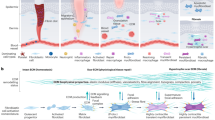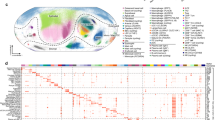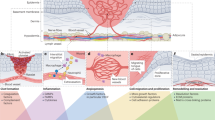Abstract
Interactions between ligands and receptors are central to communication between cells and tissues. Human airway epithelia constitutively produce both a ligand, the growth factor heregulin, and its receptors—erbB2, erbB3 and erbB4 (refs 1–3). Although heregulin binding initiates cellular proliferation and differentiation4,5,6,7, airway epithelia have a low rate of cell division8. This raises the question of how ligand–receptor interactions are controlled in epithelia. Here we show that in differentiated human airway epithelia, heregulin-α is present exclusively in the apical membrane and the overlying airway surface liquid, physically separated from erbB2–4, which segregate to the basolateral membrane. This physical arrangement creates a ligand–receptor pair poised for activation whenever epithelial integrity is disrupted. Indeed, immediately following a mechanical injury, heregulin-α activates erbB2 in cells at the edge of the wound, and this process hastens restoration of epithelial integrity. Likewise, when epithelial cells are not separated into apical and basolateral membranes (‘polarized’), or when tight junctions between adjacent cells are opened, heregulin-α activates its receptor. This mechanism of ligand–receptor segregation on either side of epithelial tight junctions may be vital for rapid restoration of integrity following injury, and hence critical for survival. This model also suggests a mechanism for abnormal receptor activation in diseases with increased epithelial permeability.
This is a preview of subscription content, access via your institution
Access options
Subscribe to this journal
Receive 51 print issues and online access
$199.00 per year
only $3.90 per issue
Buy this article
- Purchase on Springer Link
- Instant access to full article PDF
Prices may be subject to local taxes which are calculated during checkout




Similar content being viewed by others
References
Aida, S., Tamai, S., Sekiguchi, S. & Shimizu, N. Distribution of epidermal growth factor and epidermal growth factor receptor in human lung: immunohistochemical and immunoelectron-microscopic studies. Respiration 61, 161–166 (1994)
al Moustafa, A. E., Alaoui-Jamali, M., Paterson, J. & O'Connor-McCourt, M. Expression of P185erbB-2, P160erbB-3, P180erbB-4, and heregulin α in human normal bronchial epithelial and lung cancer cell lines. Anticancer Res. 19, 481–486 (1999)
Polosa, R. et al. Expression of c-erbB receptors and ligands in human bronchial mucosa. Am. J. Respir. Cell Mol. Biol. 20, 914–923 (1999)
van der Geer, P., Hunter, T. & Lindberg, R. A. Receptor protein-tyrosine kinases and their signal transduction pathways. Annu. Rev. Cell Biol. 10, 251–337 (1994)
Walker, R. A. The erbB/HER type 1 tyrosine kinase receptor family. J. Pathol. 185, 234–235 (1998)
Yarden, Y. & Sliwkowski, M. X. Untangling the ErbB signalling network. Nature Rev. Mol. Cell Biol. 2, 127–137 (2001)
Sweeney, C. et al. Growth factor-specific signaling pathway stimulation and gene expression mediated by ErbB receptors. J. Biol. Chem. 276, 22685–22698 (2001)
Wang, G. et al. Influence of cell polarity on retrovirus-mediated gene transfer to differentiated human airway epithelia. J. Virol. 72, 9818–9826 (1998)
Dempsey, P. J., Meise, K. S., Yoshitake, Y., Nishikawa, K. & Coffey, R. J. Apical enrichment of human EGF precursor in Madin-Darby canine kidney cells involves preferential basolateral ectodomain cleavage sensitive to a metalloprotease inhibitor. J. Cell Biol. 138, 747–758 (1997)
Aguilar, Z. & Slamon, D. J. The transmembrane heregulin precursor is functionally active. J. Biol. Chem. 276, 44099–44107 (2001)
Campiglio, M., Ali, S., Knyazev, P. G. & Ullrich, A. Characteristics of EGFR family-mediated HRG signals in human ovarian cancer. J. Cell. Biochem. 73, 522–532 (1999)
Mostov, K. E., Verges, M. & Altschuler, Y. Membrane traffic in polarized epithelial cells. Curr. Opin. Cell Biol. 12, 483–490 (2000)
Wodarz, A. Tumor suppressors: linking cell polarity and growth control. Curr. Biol. 10, R624–R626 (2000)
Kennedy, S. M., Elwood, R. K., Wiggs, B. J., Pare, P. D. & Hogg, J. C. Increased airway mucosal permeability of smokers. Relationship to airway reactivity. Am. Rev. Respir. Dis. 129, 143–148 (1984)
Sobonya, R. E. & Taussig, L. M. Quantitative aspects of lung pathology in cystic fibrosis. Am. Rev. Respir. Dis. 134, 290–295 (1986)
Godfrey, R. W. Human airway epithelial tight junctions. Microsc. Res. Tech. 38, 488–499 (1997)
Goto, Y. et al. Dislocation of E-cadherin in the airway epithelium during an antigen-induced asthmatic response. Am. J. Respir. Cell Mol. Biol. 23, 712–718 (2000)
Karp, P. H. et al. in Epithelial Cell Culture Protocols (ed. Wise, C.) 115–137 (Humana, Totowa, New Jersey, 2002)
Walters, R. W. et al. Adenovirus fiber disrupts CAR-mediated intercellular adhesion allowing virus escape. Cell 110, 789–799 (2002)
Acknowledgements
We thank P. Karp, P. Weber, J. Launspach, T. Nesselhauf, L. Panko, T. Mayhew and D. Vermeer for technical assistance. We appreciate the help of the Iowa Statewide Organ Procurement Organization. We also thank the University of Iowa In Vitro Models and Cell Culture Core (supported in part by the National Heart, Lung and Blood Institute (NHLBI), the Cystic Fibrosis Foundation, and the National Institutes of Diabetes and Digestive and Kidney Diseases (NIDDK)), and the University of Iowa Central Microscopy Research Facility. This work was supported by the NHLBI, the CFF, and the Howard Hughes Medical Institute. P.D.V. was supported by a K01 award from the NIDDK. M.J.W. is an Investigator of the Howard Hughes Medical Institute.
Author information
Authors and Affiliations
Corresponding author
Ethics declarations
Competing interests
The authors declare that they have no competing financial interests.
Supplementary information
Rights and permissions
About this article
Cite this article
Vermeer, P., Einwalter, L., Moninger, T. et al. Segregation of receptor and ligand regulates activation of epithelial growth factor receptor. Nature 422, 322–326 (2003). https://doi.org/10.1038/nature01440
Received:
Accepted:
Issue Date:
DOI: https://doi.org/10.1038/nature01440
This article is cited by
-
NRG1 fusions in breast cancer
Breast Cancer Research (2021)
-
Unraveling mucin domains in cancer and metastasis: when protectors become predators
Cancer and Metastasis Reviews (2020)
-
Three new compounds with nitric oxide inhibitory activity from Tirpitzia sinensis, an ethnomedicinal plant from Southwest China
BMC Chemistry (2019)
-
Mouse embryo geometry drives formation of robust signaling gradients through receptor localization
Nature Communications (2019)
-
What is the identity of fibroblast-pneumocyte factor?
Pediatric Research (2016)
Comments
By submitting a comment you agree to abide by our Terms and Community Guidelines. If you find something abusive or that does not comply with our terms or guidelines please flag it as inappropriate.



